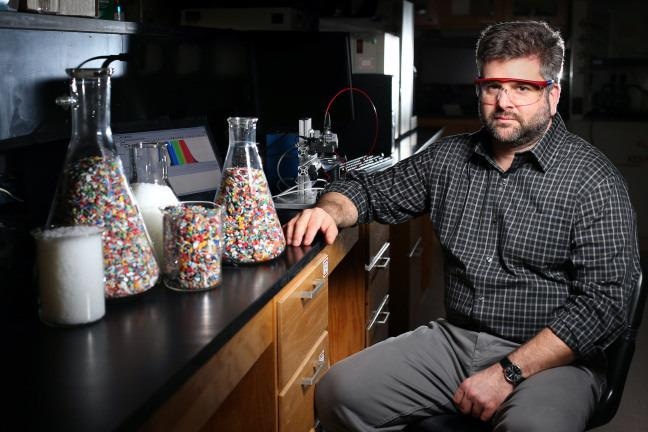Chemicals employed to “greaseproof” a multitude of items, from food packaging to carpets, have accumulated in the environment for numerous years and pollute ecosystems worldwide. A new study is seeking a better understanding and awareness of the dangers posed by these chemicals.
 Keith Vorst with bits of recycled bottles inside one of his laboratories in the Food Sciences Building. Vorst is studying potential mitigation strategies such as high voltage atmospheric cold plasma to change the chemistry of PFAS. Image Credit: Christopher Gannon.
Keith Vorst with bits of recycled bottles inside one of his laboratories in the Food Sciences Building. Vorst is studying potential mitigation strategies such as high voltage atmospheric cold plasma to change the chemistry of PFAS. Image Credit: Christopher Gannon.
The study, published in the academic journal Trends in Food Science & Technology, collects the reports of a symposium lead by an Iowa State University researcher and delivered a call to action on the necessity for new and improved methods to detect and alleviate this group of chemical compounds, jointly called per- and polyfluoroalkyl substances (PFAS).
Evidence shows exposure to high levels can result in adverse health effects for humans and other species, and the study highlights the need for new methods to quantify and examine exposures to these artificial chemicals from numerous sources, including food.
PFAS amass in the environment and will not break down on their own. For instance, the compounds can pollute waterways after leaching from products thrown away in landfills, said Keith Vorst, director of the Polymer and Food Protection Consortium and an associate professor of food science and human nutrition at Iowa State.
Since the 1940s, these completely manmade chemicals have been used in a variety of products, and some states have passed legislation to limit their use. Yet, their capability of persisting in the environment means the compounds that already are present can continue to pollute the environment.
They’re out there, we need to be aware of them, and it’s really hard to eliminate them. We need to work on mitigation strategies, and we need to be monitoring them and better understand the risks they pose.
Keith Vorst, Associate Professor of Food Science and Human Nutrition, Iowa State University
What Are PFAS?
PFAS have frequently been used to coat food packaging as a barrier to prevent grease from seeping out. Vorst said paper wrappers on hamburgers are regularly coated in these compounds to prevent grease from seeping through and messing up consumers’ hands. The compounds have also been employed extensively to coat carpets, in fire-fighting foams and in car interiors.
A few PFAS are no longer manufactured in the United States, but Vorst said over 5,000 individual compounds qualify under this group, making it hard for regulations to keep pace with newly produced chemicals.
Studies have shown that exposure to high levels of a few of these chemicals can result in reproductive and developmental, kidney and liver, and immunological effects in lab animals, according to the Environmental Protection Agency (EPA).
The EPA reports the most consistent conclusions are higher levels of cholesterol among exposed populations, and studies have found inadequate evidence for connections between high levels of some PFAS and low infant birth weights, cancer, effects on the immune system and thyroid hormone disturbance.
Monitoring and Mitigation
The new study materialized from a virtual symposium conducted in June of 2020 organized by the Institute for the Advancement of Food and Nutrition Sciences. The symposium hosted engineers, scientists and regulatory professionals from private, public and academic institutions.
The symposium looked at science gaps for exposure routes, detection and quantification of PFAS in food. Speakers also observed that, based on inadequate data to date, there is little PFAS noticed in food.
Polymer and Food Protection Consortium scientists Greg Curtzwiler, an assistant professor of food science and human nutrition, and Paulo Silva, adjunct assistant professor of food science and human nutrition, are working with Vorst in the laboratory to examine possible mitigation approaches such as high voltage atmospheric cold plasma to alter the chemistry of PFAS.
This method could work by passing materials that have PFAS, such as product packaging or even drinking water, through a controlled atmosphere to alleviate the compounds.
The team has tested the technique and is collaborating with Iowa State to patent the technology. Vorst’s PFPC lab has been exploring new methodologies to identify and track PFAS levels in different environments as well. Much of this study received funding from the ISU Polymer and Food Protection Consortium.
We’re looking at continuous monitoring of exposure limits. We’re trying to develop threshold limits for packaging and products. We’re also looking at how we can change these chemistries to get them out of the environment, make them less persistent or sequester them.
Keith Vorst, Associate Professor of Food Science and Human Nutrition, Iowa State University
Journal Reference:
Vorst, K, L., et al. (2021) Risk assessment of per- and polyfluoroalkyl substances (PFAS) in food: Symposium proceedings. Trends in Food Science & Technology. doi.org/10.1016/j.tifs.2021.05.038.